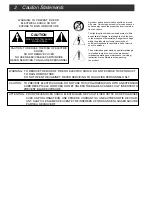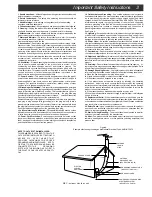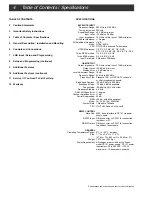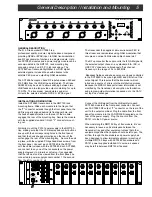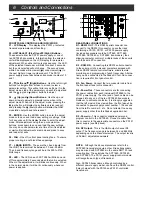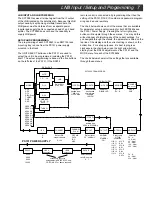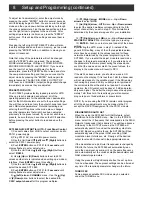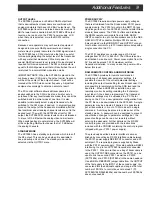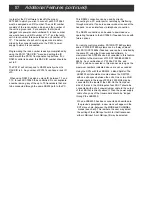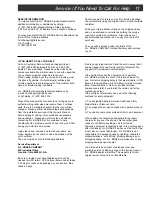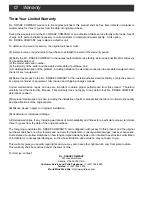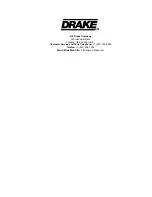
Additional Features 9
OUTPUT LEVEL
The SCT2860 provides a +40 dBmV QAM output level
that is desirable when transcoders are combined with
analog modulators that have +45 dBmV output level. The
SCT2860 output level can be turned down as much as 15
dB if a lower level is desired. Each SCT2860’s RF output
level can be read out on the PS151 power supply LCD
when that unit is selected, or via the RS232 remote
connection.
Because some operators may not have test equipment
designed to measure QAM power levels, and analog
meters may be grossly inaccurate if a QAM signal is read,
the SCT2860 has a CW output mode that can be useful
for measuring/adjusting the output level of the transcoder
with any meter that measures CW carrier power. A
special QAM instrument is not required. No input signal is
required for this measurement. The CW carrier power is
equal to the QAM power level that will result when the unit
is returned to a normal QAM modulation mode.
IMPORTANT NOTE: When the SCT2860 is placed in the
continuous wave (CW) mode, the output carrier frequency
will be at the center of the output channel. It will not be
located at the NTSC video carrier frequency. Adjust test
equipment accordingly to obtain an accurate result.
The PC control software allows all transcoders to be
easily switched to the CW mode at one time for set up
purposes. After any level tweaks are made, they can all be
switched back to normal mode at one time. It is also
possible to individually select a single transcoder to be
switched to the CW mode, if desired. In a typical leveling
process, the output of the headend is monitored after the
final combiner and all analog channel levels are set to the
desired level. Then, with the SCT2860s all set for CW
output, the SCT2860 CW carrier levels can be all tweaked
to a level of 10 dB below the analog video carrier levels.
When switched back to normal mode, the SCT2860s will
all be outputting QAM output power that is 10 dB below
the analog channels.
STANDBY MODE
The SCT2860 has a standby output mode which turns off
the RF output. This can be used when it is desirable to
keep a backup unit on line. The standby mode can be
selected via the OUTPUT menu.
POWER SUPPLY
The SCT2860 requires multiple power supply voltages
that are all obtained from the Drake model PS151 power
supply module. The PS151 mounts in the RMT150 rack
tray along with one to ten SCT2860 (or other similar Drake
models) transcoders. The PS151 buffers and distributes
the RS232 remote control data from its DB9, RS232
INPUT connector to up to ten transcoders and to the DB9,
RS232 OUTPUT connector. Multiple PS151s can be
‘daisy chained’ via the DB9 INPUT and OUTPUT connec-
tors to allow control of up to 70 transcoder modules with a
single connection to a PC.
The PS151 operates over a wide range of AC input
voltages from 90 VAC to 264 VAC. The USA version has
an attached 3 wire line cord. Power consumption from the
AC line will be around 150 W maximum with ten
transcoders installed. In many cases, the power will be
below this level.
RS232 REMOTE CONTROL AND MONITORING
The SCT2860 provides for remote control and/or
monitoring of all transcoder parameter settings. It is
possible to view all of the current parameter settings
including the output level setting for each transcoder. It is
also possible to remotely monitor the SNR level and the
baud rate. When a LBS2250 is installed, one can
remotely monitor its setting including the 8 character
input label if it has been programmed. The transcoder
parameter settings may be uploaded to a PC file for
saving on the PC or a new parameter configuration from
the PC file can be downloaded to the SCT2860. A single
parameter may be adjusted if desired. It is possible to
put all transcoders in or out of CW mode with a single
command. A unit may be placed in or taken out of the
standby mode. A password can be assigned to prevent
unauthorized changes to parameter settings but the
present settings can be read out remotely without
entering the password. Further details on the RS232
control program are provided with the instructions
included with the CDROM containing the control program
(shipped with your PS151 power supply).
The previously described remote interface is accom-
plished by connecting an RS232 interface cable between
the PS151 power supply DB9 INPUT connector and a PC
serial port. The required program is supplied by Drake
with the PS151 power supply. This setup will allow RS232
interfacing to up to ten SCT2860 transcoders connected
to the PS151. When more than one tray of transcoders is
used, the OUTPUT DB9 connector on the PS151 can be
used to link to a second PS151 as well as a PS150
(SCT1860s) or a PS100 (SCT860s) in the same headend.
Use a DB9 to DB9 RS232 jumper cable from the OUTPUT
of the first supply to the INPUT of the second supply. You
can extend this to additional supplies as long as the total
number of PS151s to control does not exceed 7 (70
SCT2860/1860/3860/4860s) and the number of SCT860s
does not exceed 64.


